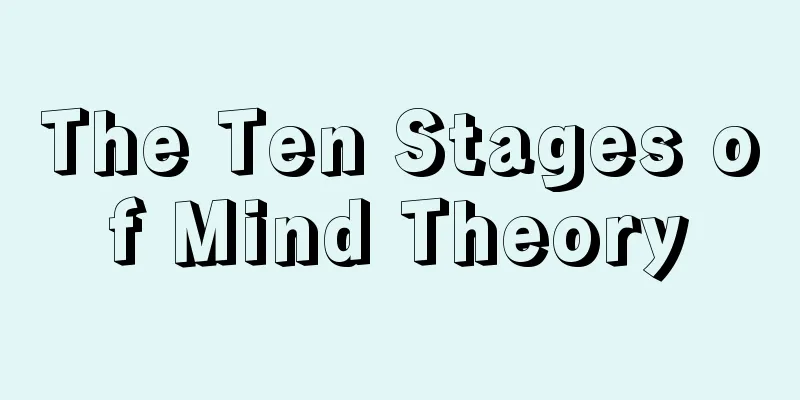The Ten Stages of Mind Theory

|
A Buddhist book. For details, see "Himitsu Mandala Jujushinron." Ten volumes. In 830 (Tencho 7), during the early Heian period, Kukai compiled this work by imperial order of Emperor Junna along with the three volumes of "Hizo Hoyaku." It is his two greatest works. "Junshin" means the world of the mind, and is divided into 10 stages of development and improvement from lower to higher dimensions. Living according to animal instinctual desires (first, the mind of a sheep born from another world). Coming into contact with a certain opportunity, a moral and ethical mind emerges (second, the mind of a foolish child with self-control). Gaining religious awareness, one aspires to be born in heaven (third, the mind of an infant with no fear). Next, the shravakas' teaching of selflessness (fourth, the mind of only aggregate selflessness) and the pratyekabuddhas' teaching of removing fundamental ignorance (fifth, the mind of removing karma-cause seeds) are explained. These are Hinayana, but they are included in the provisional Mahayana teachings, such as the Hosso sect's teaching on compassion (No. 6, Other-dependent Mahayana Mind), the Sanron sect's teaching on emptiness (No. 7, Enlightened Mind, Unborn Mind), the Tendai sect's teaching that everything is true (No. 8, One Way, No-action Mind), and the Kegon sect's teaching on the realization of individual values (No. 9, Extremely Non-self-nature Mind). All of the above are exoteric teachings, but esoteric Buddhism teaches the world of mandalas, where infinite development is shown (No. 10, Secret Magnificent Mind). Esoteric Buddhism encompasses each exoteric teaching. On the other hand, the Ten Stages of Mind also form a history of thought that integrates Buddhist sects, other religions, and philosophies. [Yukatsu Miyasaka] Source: Shogakukan Encyclopedia Nipponica About Encyclopedia Nipponica Information | Legend |
|
仏教書。詳しくは『秘密曼荼羅(ひみつまんだら)十住心論』。10巻。平安初期、830年(天長7)に淳和(じゅんな)帝の勅命により、空海が『秘蔵宝鑰(ひぞうほうやく)』3巻とともに撰進(せんしん)したもので、彼の双璧(そうへき)の主著。 住心は心の世界を意味し、これを低次元より高次元へと発展向上する10種の段階に分ける。動物本能的な欲望のままに生きる(第一異生羝羊心(いしょうていようしん))。ある機縁に触れて道徳的、倫理的な心が芽生える(第二愚童持斎心(ぐどうじさいしん))。宗教的な自覚を得て、天界に生まれることを願う(第三嬰童無畏心(ようどうむいしん))。次に声聞(しょうもん)の無我の教え(第四唯蘊無我心(ゆいうんむがしん))、縁覚(えんがく)の根源的無知を取り除く教え(第五抜業因種心(ばつごういんじゅしん))を説く。これらは小乗であるが、仮の大乗の教えに入って、法相(ほっそう)宗の慈悲(じひ)の教え(第六他縁大乗心(たえんだいじょうしん))、三論宗の空(くう)の教え(第七覚心不生心(かくしんふしょうしん))、真実の大乗である天台宗の一切(いっさい)は真実であると説く教え(第八一道無為心(いちどうむいしん))、華厳(けごん)宗の個別的価値の実現を説く教え(第九極無自性心(ごくむじしょうしん))がある。以上はすべて顕教であるが、密教は無限の展開が示される曼荼羅の世界を説く(第十秘密荘厳心(ひみつしょうごんしん))。密教は個々の顕教を包摂する。他方また、十住心は仏教諸宗、他の諸宗教、哲学を綜合(そうごう)した思想史をも形成する。 [宮坂宥勝] 出典 小学館 日本大百科全書(ニッポニカ)日本大百科全書(ニッポニカ)について 情報 | 凡例 |
>>: Jushiyama [village] - Jushiyama
Recommend
Prostitute - Gyu
A male servant at a brothel. Also called gyutaro....
Stable isotope labeled compounds
...Tracers used in the fields of chemistry and bi...
Kawachi Kusunoki Nyudo
…The Kanze Genealogy states that the daughter of ...
Vercingetorix (English spelling)
A chieftain of Gaul during the Roman Republic'...
Johnson, R.
… Representative performers (who in most cases al...
Mondory
...In this way, the "King's Theatre"...
Okuna multiflora - Okuna multiflora
...The ovary is deeply divided into 3-10 lobes, e...
Neoregelia carolinae (English spelling)
… [Takabayashi Masatoshi]. … *Some of the termino...
liaison
…Add water, lemon juice, and spices, simmer for 2...
Wojciechowska, M.
...Other authors include E. G. Speare, who wrote ...
Goujon, Jean
Born around 1510. Normandy? [Died] about 1568. Fre...
Pyrus ussuriensis (English spelling) Pyrusussuriensis
… [Yukio Taniguchi]. … *Some of the terminology t...
Economic circulation
It refers to the overall flow of economic activit...
Dynamometer - Dynamometer
A device that measures the power generated by prim...
Ibn Muhalhir - Ibn Muhalhir
…Years of birth and death unknown. Also known as ...









